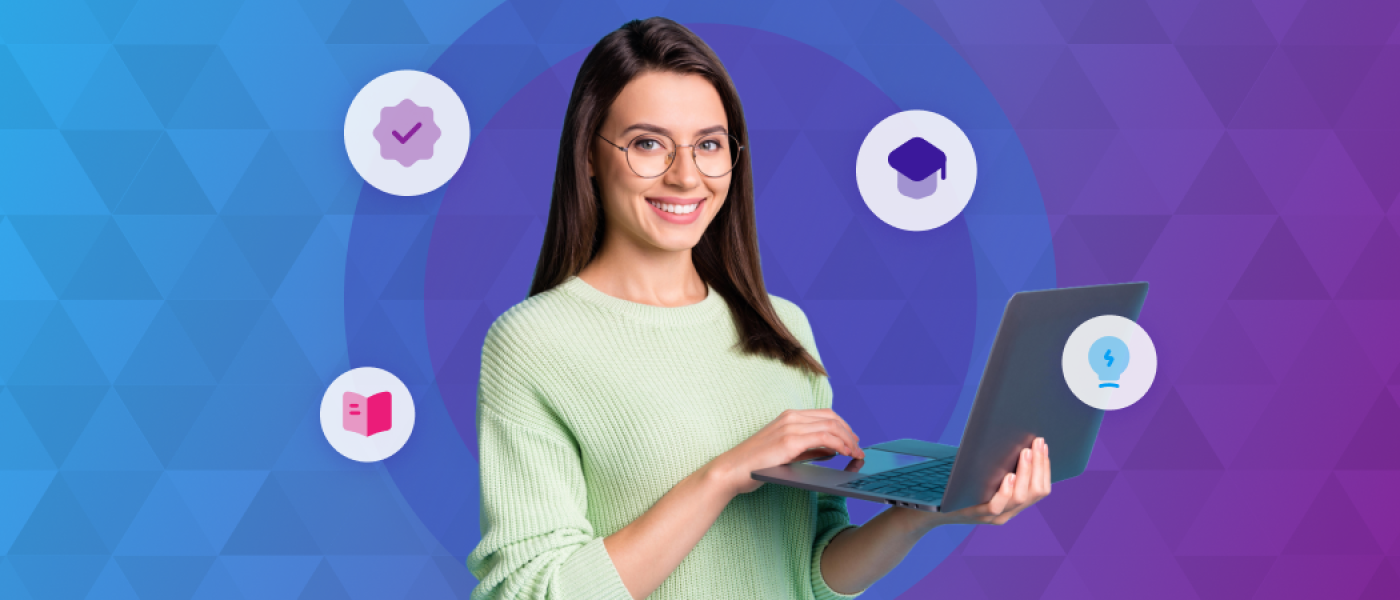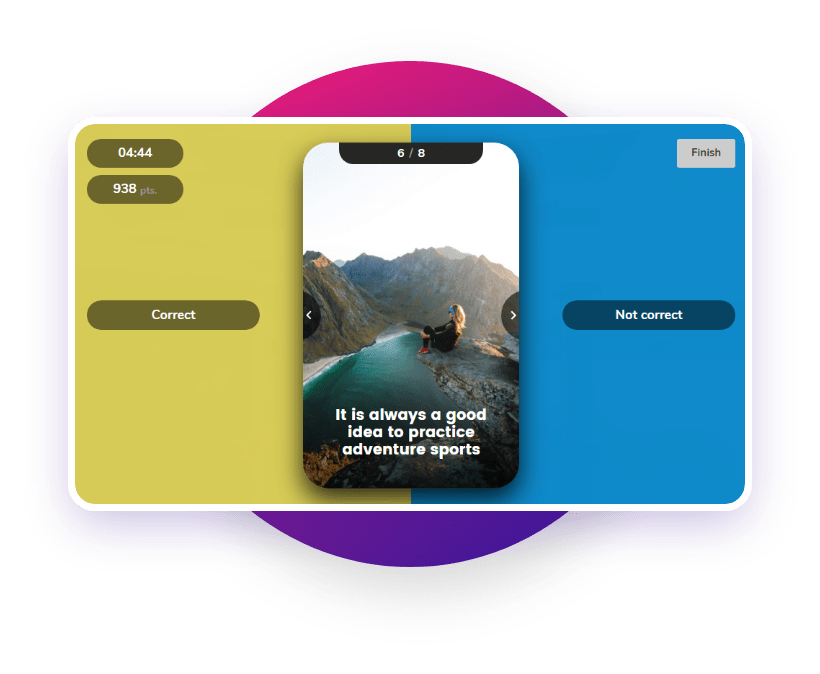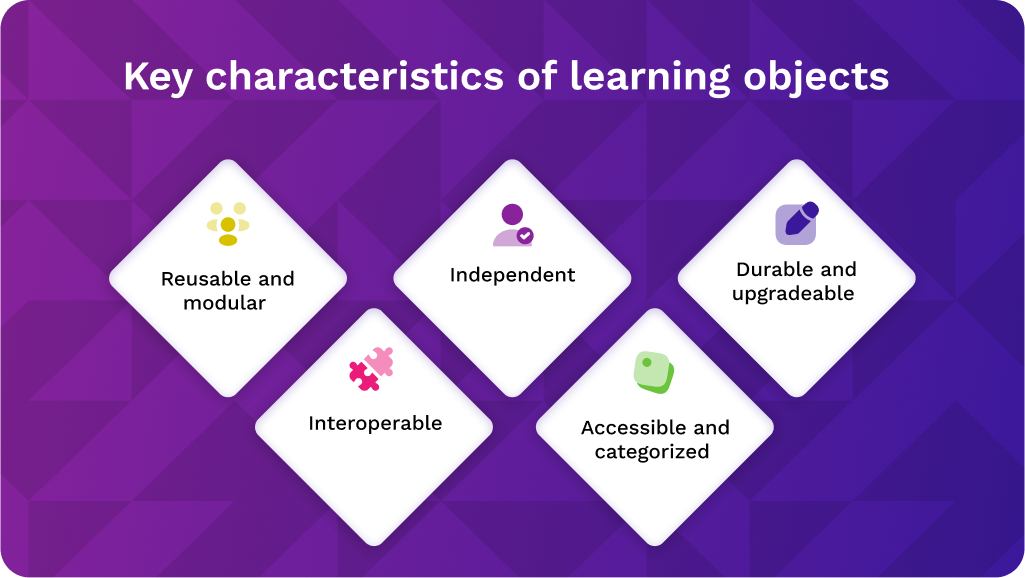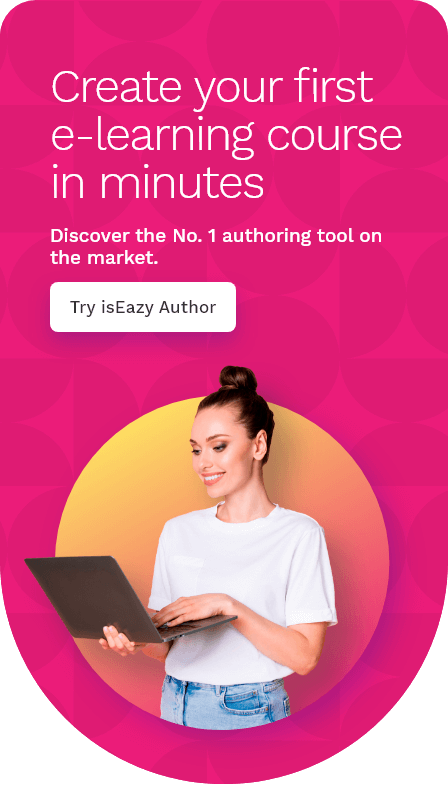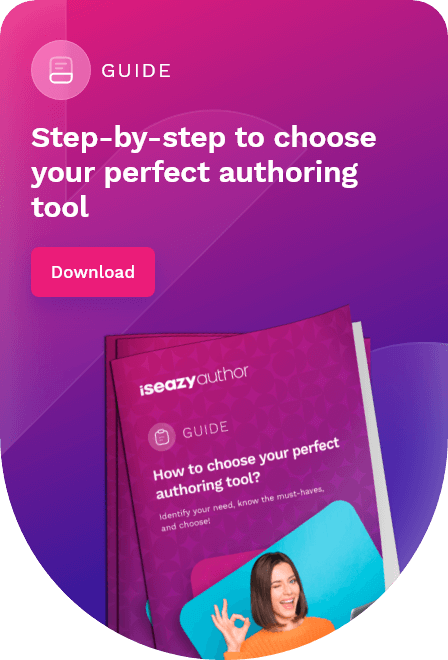Table of contents
ToggleWe live in an age marked by the omnipresence of technology. We find it everywhere, in all aspects of our lives, and education and vocational training are no exceptions to this. It’s here, in the field of corporate training, where learning objects emerge as a fundamental tool to enrich the student experience, offering digitized content that enhances interactive learning.
From videos to dynamic presentations and even interactive elements, learning objects add plenty of value to training. They allow students to access focused fragments of knowledge in just a few clicks, and also adapt easily to individual learning rhythms and styles. Eager to discover more about learning objects and how they can be used in corporate training? We reveal all below.
What are learning objects?
Learning objects are units of digital content that provide specific pieces of information to students. They are designed to facilitate teaching and learning, and take the form of short pieces or small fragments which include features like text, images, videos, interactive simulations or animations. These elements work together (or separately) to ensure the assimilation and retention of learning content.
How are the learning objects used in training?
In training, learning objects are blocks of information that can be easily reused and combined. They are often integrated into educational materials, online courses or learning management systems (LMS) to enrich the student experience. Trainers can use them to explain complex concepts, provide practical examples, or evaluate student progress. Additionally, their flexibility makes them versatile tools that can be adapted to the specific needs of different audiences.
The elements of learning objects
Learning objects are made up of several cohesive elements that work together to offer a comprehensive educational experience. These elements are carefully selected and designed, with the intention of building complete and effective learning resources. Some of the most important elements include:
Learning objectives
Learning objectives clearly and specifically define the skills and competencies a student must acquire during the learning experience. They act as a guide, outlining what the student can expect to achieve upon successful completion of their module or course. At the same time, setting such objectives make it possible to measure the effectiveness of any learning objects you include against them.
Educational content
Educational content is, naturally, a crucial element in the design of learning objects. In fact, this content is made up of all the knowledge, concepts or educational information that you wish to transmit to students through a learning object. Educational content can be offered through various formats such as videos, images, presentations or games, that all enrich the learning experience in their own way.
Practical activities
Learning objects must include activities, such as exercises, that allow students to test, practice and apply the knowledge they have acquired. Some of the most commonly used activities in e-learning are simulations, interactive videos, games and exercises.
Evaluations
Evaluations allow us to measure the degree of understanding and level of knowledge possessed by students. They are useful and important tools, which provide vital feedback allowing students to get to know their strengths and weaknesses throughout the learning process. Evaluations typically include quizzes, tests, or hands-on student projects.
Metadata
Finally, learning objects must include a range of general information about their purpose in the form of metadata. This can include title, author, keywords or any other data that allows the object to be classified and searched for within an online platform. This element is crucial since it allows you to locate and subsequently reuse the object across different e-learning contexts.
Key characteristics of learning objects
In order for a digital resource to become a learning object specifically, it must bear certain characteristics. Learning objects must be:
- Reusable and modular: Learning objects must be designed to be reusable and modular, which means that they can be easily integrated into different types of e-learning content, as well as adapted to various educational contexts. Modularity allows one learning object to be combined with another in order to create more complete and personalized learning experiences.
- Independent:Each learning object must be able to transmit a concept or skill independently – in and of itself – without requiring the use of external resources. This feature ensures that the object can be used effectively – both individually and in possible combination with other educational materials.
- Interoperable: Learning objects must be compatible with a variety of digital platforms and learning management systems (LMS). To achieve this, one can follow international interoperability standards that ensure the smooth operation of the object in different technological environments.
- Durable and upgradeable: It’s essential that learning objects are durable and can be easily updated to reflect the latest developments in knowledge and technique. Their structure must allow changes and modifications to be made without affecting potential compatibility with other hardware and software, thereby guaranteeing continued relevance over time.
- Accessible and categorized: Finally, learning objects must be categorized and tagged with appropriate metadata so they can be accessed and retrieved with ease. This ensures that users can locate and use content efficiently.
The importance of learning objects in the professional environment
Learning objects play a crucial role in the professional world, where training and skill development are key to organizational success. For one thing, learning objects allow companies to offer more personalized and adaptive training opportunities to their employees.
Being modular and reusable, these digital resources are a highly cost-effective solution for providing employee training. They can be designed to meet specific needs, and address particular skill areas or business challenges. This flexibility helps to ensure that training programs are relevant and effective for each individual within an organization.
With both a flexible structure and the capacity to be updated regularly, learning objects allow companies to remain agile and adapt quickly to unpredictable market changes. Another of their advantages in the business world is their ability to foster collaboration and knowledge sharing between employees. By integrating interactive elements and even social learning activities, they help to nurture a collaborative learning environment where employees can share experiences, solve problems together, and even learn from each other.
How to use learning objects in training
Learning objects can be used in various ways within the training process to both enrich the educational experience and make teaching and learning easier.
1. Integrate them into courses and educational materials
Learning objects can be easily integrated into courses, seminars, workshops or online training programs. They can be used as either primary or secondary resources to explain key concepts, offer practical examples, or present relevant case studies.
2. Create online courses
Learning objects are fundamental components in the creation of online courses or e-learning training. You can use them to design interactive learning modules, multimedia presentations, practical activities and even formative assessments. This allows students flexible access to content that is specifically adapted to their needs and learning pace.
3. Develop digital educational resources
Learning objects can also be used to create a variety of digital educational resources, such as video tutorials, interactive infographics, simulations and educational games.
4. Apply them within learning management systems (LMS)
Learning objects work well when integrated into learning management systems (LMS) to help organize and manage educational content. Educators can use learning objects to assign homework and evaluate student progress with a high degree of efficiency.
5. Use them to provide self-assessment and feedback options
Interactive learning objects, such as online quizzes, practical exercises, and reinforcement activities, are useful in offering self-assessment opportunities and providing immediate feedback to students. This allows you to monitor their progress, identify areas for improvement and consolidate students’ understanding of the concepts being taught.
Types of learning objects and how to design them effectively
There are many different types of learning objects, and below we take a closer look at three of them:
- Videos
Whether they function as tutorials, animations or representations, videos are highly valuable virtual learning objects when it comes to engaging students. Users can watch them as many times as they want, pause them, and even fast forward or slow them down.
- Presentations
Classic elements of e-learning, which are not only limited to text, but can also include images, videos or audios. They are easy resources to create and are an excellent way to summarize information and make it more attractive.
- Interactive elements
Interactive learning objects are one of the best ways to encourage student participation and engagement. Choose from an array of interactive elements to enrich your training content, such as cards, interactive videos, grouping or linking exercises and branching scenarios.
To create learning objects effectively, it is essential to follow a structured development process. This includes first defining learning objectives, then selecting the most relevant content for your goals, and finally choosing the right technology for implementation. In addition, it is important to take into account elements such as accessibility, usability and an attractive design to maintain interest.
The benefits of using learning objects when designing a curriculum
The inclusion of learning objects in curricular design offers numerous benefits. Firstly, since learning objects can be easily used across various educational contexts, they increase the efficiency of the teaching process, allowing educators to focus on personalized teaching rather than having to create content from scratch.
Other benefits of learning objects include that they help learners better retain information, allow them to follow personalized learning paths, and cater to modern, busy students who prefer to consume content in small, easy-to-digest pieces.
Additionally, learning objects encourage active student participation by providing access to interactive and visually engaging resources. They also offer immediate feedback and allow for the monitoring of student progress, which contributes to more effective learning overall.
By creating and including learning objects in your training, you can easily customize your content to adapt to a wide range of audiences and objectives. Don’t know where to start? Try isEazy Author, our authoring tool specially designed to create attractive, accessible and dynamic e-learning courses in just a few minute.
